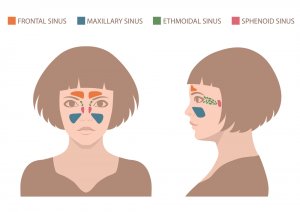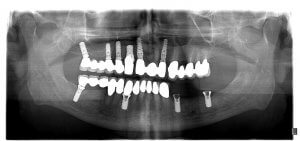Being told you need a sinus lift before getting dental implants may seem daunting, but there is no need to worry. It's a relatively common surgical procedure that can make it possible for you to restore your dentition with implants even after suffering bone loss.
Here you can read all about what the sinus lift procedure involves, what it costs in the UK, and what to expect during recovery. Don't miss our tips for reducing the cost of the procedure – it's possible to save hundreds if you know how!
Table of contents
What is a sinus lift operation?


It's a surgical procedure which grafts bone to the upper jaw at the position of the molar and premolar teeth. The maxillary sinus membrane is lifted upwards to make space for the additional bone.
The sinus system has several parts but it's the maxillary sinuses which sit closest to our teeth. You might sometimes get a toothache when you have congestion or a bad cold – this is because the pressure on the sinuses transfers to the tooth roots in the upper jaw.
The technical name for this procedure is a “maxillary sinus floor augmentation” but you may also hear the terms “sinus augmentation” and “sinus graft” used. A specially trained dental clinician, periodontist or oral surgeon carries out the surgery.
Will I need a sinus lift for dental implants?
A sinus augmentation is usually performed when a patient has insufficient bone in their upper jaw to support a dental implant, as shown by a panoramic dental x-ray. Dental implants fuse with the jaw bone in a natural process called osseointegration, but this relies on there being a certain amount of bone present.
You may need sinus augmentation surgery before getting implants if:
- your jaw bone has previously been damaged, for example from trauma or a difficult extraction;
- a cyst or tumour has been removed from the area;
- you have suffered bone loss as a result of periodontitis;
- your bone has receded because of tooth loss (the socket can lose 40-60% of its bone structure within the first three years);
- you naturally have a large sinus cavity or thin jaw bone.
Not everyone who gets molar or premolar teeth implants will need this surgery. However, it's a fairly common procedure. If you are nervous about having oral surgery, your dentist may offer you conscious sedation to make you more relaxed during the treatment.
Mini implants might let you avoid the worry and cost of a sinus lift, but they aren't always a great solution.
What does it involve?
Preparation


To begin with, your dental surgeon will conduct a consultation to discuss your needs. As part of this they will take dental x-rays, and perhaps CT scans, to assess the current condition of your jaw and ascertain whether you are a suitable candidate for a sinus procedure.
The grafted bone can be sourced from a number of places:
- Your own body (either from another part of your mouth or another bone – often in the hip or leg)
- Another human (people may donate their bone tissue when they die)
- Cow bone
- A synthetic material such as hydroxyapatite
All of these materials are safe and are processed to ensure they are free from disease. Our full guide to dental bone grafting explains more about the different options.
Surgical procedure
There are various ways to carry out sinus graft surgery. They all begin with making an incision in the gum to expose the bone underneath.
Most commonly, the dentist cuts a small “window” into the bone and pushes it up to reveal the sinus cavity. The cavity membrane is lifted and the space below filled with granules of the bone graft material.
Then, the gum tissue is stitched back together.
In the sinus lift procedure video below a doctor explains more about how this works:
The technique your dentist uses may be different, depending on your personal circumstances. Be sure to discuss this if you have any concerns.
Recovery
Immediately after your surgery you may experience swelling in the area and bleeding from your mouth or nose. You'll probably feel uncomfortable for a few days afterwards but most patients don't experience major discomfort. If any bleeding continues for more than two days, or pain and swelling get worse, you should contact your dentist immediately.
There is a risk of the sinuses becoming infected but your dentist will give you medication to protect against this. After 7-10 days you'll return to your dentist so he can check the progress of your healing and remove your stitches, if they haven't dissolved by themselves. You'll have several more visits during the healing process to check everything is going as planned.
You need to take care to protect the area that has undergone surgery. The sinuses are particularly susceptible to damage while you recover. The following tips will aid healing from a sinus lift:
- During the first 24-hour period, do not spit or rinse. This can disturb the blood clot or open the wound, prolonging bleeding and hindering healing.
- After 24 hours you can rinse with salt water 4-5 times a day, especially after meals and before bed.
- Do not brush near the surgical site for 48 hours. After that, be very careful to brush gently in that area.
- Do not drink from a straw for 7-10 days as this creates suction which can dislodge blood clots.
There are also some everyday actions and activities you should avoid:
- Do not drink from a straw for 7-10 days as this creates suction which can dislodge blood clots.
- It's best to avoid smoking for the duration of your recovery, but for 7-10 days as a minimum.
- Do not blow your nose for 4 weeks after surgery.
- If you need to sneeze, do it with your mouth open to avoid extra pressure in the nasal cavity.
- For 3-4 weeks, avoid blowing up balloons or playing a musical instrument that involves blowing. Also do not scuba dive or travel in a pressurised aircraft if possible.
– Dr Eyad Tariq
Placing the implants
Most often patients must wait 4-9 months before they receive their implants. This gives the bone a chance to fuse in its new position. The exact waiting time will depend on the type of material used.
It is possible in some cases to place the implants as part of the sinus surgery – without any waiting period. One study has shown that although this method is quite safe, the success rate is lower in patients who have a residual bone height of less than 4mm.
You might be keen to get your implants placed sooner rather than later, but your dentist will advise you on the method that is likely to achieve the best results.
How much does a sinus lift cost in the UK?


A sinus lift costs around £600 to £3,000 in the UK. These costs are per side, and may be higher depending on how complex the work is and how much bone graft material is required. If you have already received a quote for implants, check whether this includes any preparatory surgeries.
Dental implants are usually not available on the NHS in the UK, and the same goes for any preparatory surgery. So, if you're paying privately for your implants, you'll have to pay privately for your sinus graft too.
Ways to save money on sinus surgery
Getting teeth implants is costly enough without having to fork out hundreds or thousands of pounds just to prepare your mouth for them. Fortunately, there are ways you can save money on your sinus lift procedure costs.
Firstly, enquire about prices with several different dental clinics in your area. Not every dentist has the specialist training to perform this procedure, but among those that do, you might find quite a variance in price.
Secondly, consider getting your sinus augmentation treatment abroad (and even your implants, too!). The cost of oral surgery in countries like Hungary and Turkey is much lower than in the UK but clinics are subject to the same high standards. They are also cheap to reach with a low-cost airline.
Below is a table showing average sinus lift costs in different countries:
Country | Average cost |
UK | £800 - £2,500 |
Hungary | £350 - £500 |
Poland | £500 - £650 |
Thailand | £500 - £600 |
Mexico | £450 - £600 |
If you need sinus lift surgery for implants, read our other tips for saving money on dental implants.


Sinus lift risks and complications
The main risk of this surgery is the piercing or tearing of the membrane. In the rare event that this happens, it can be stitched or patched to repair it. Often the surgery can still continue as planned; in other cases the membrane must be given time to heal before the lift takes place.
There is also a chance that the body will reject the bone graft, eventually pushing it out from where it was placed. Infection is a common risk of any surgery, but antibiotics are usually prescribed to protect against this. If you're given a course of antibiotics, it's important to finish them all.
You should visit your implant surgeon if you experience any of the following the surgery:
- An unusual flow of liquids or air between your nose and mouth
- Small graft particles discharging from your nose
- An increase of nasal or sinus congestion near the surgical site
- An increase in swelling (after 3 days) on your cheek, mouth, or below the eyes.
In addition, take any medication as prescribed and follow your surgeon's advice for recovery.
– Dr Eyad Tariq
Conclusion
Getting a sinus lift for dental implants is nothing to worry about, but you should research the procedure and understand what it involves before committing to it. Follow your doctor's instructions for aftercare and recovery, and the procedure has a high chance of success. If you notice any side effects which concern you, speak to your doctor straight away.
After your sinus lift and bone graft, you'll need to wait 4-9 months before being able to get your implants. Still, it'll be worth the wait when you do eventually have your smile fully restored!
And remember, you can chat with a dentist at any time — 24/7 about your temporary crowns. A team of certified dentists is standing by at JustAnswer.
Foundation for Oral Rehabilitation: Sinus lifting. Consulted 24th April 2019.
National Center for Biotechnology Information: Comparative study of immediately inserted dental implants in sinus lift: 24 months of follow-up. Consulted 24th April 2019.
National Center for Biotechnology Information: Maxillary Sinus Floor Augmentation: a Review of Selected Treatment Modalities. Consulted 24th April
Indian Journal of Dental Sciences: Sinus lift procedures in dental implants: A literature review on techniques, recommendations, and complications. Consulted 20th November 2020.




